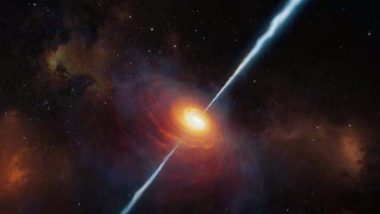London, March 9: With the help of the European Southern Observatory's Very Large Telescope (ESO's VLT), astronomers have discovered the most distant quasar with powerful jets emitting at radio wavelengths. The discovery of this 'radio-loud' quasar, published in The Astrophysical Journal, could provide important clues to help astronomers understand the early universe.
Quasars are very bright objects that lie at the centre of some galaxies and are powered by supermassive black holes.
As the black hole consumes the surrounding gas, energy is released, allowing astronomers to spot them even when they are very far away. Scientists Speculate Hi-Tech Aliens After Australian Telescopes Receive Mysterious Fast Radio Bursts Signals From Deep Space.
The newly discovered quasar, nicknamed P172+18, is so distant that light from it has travelled for about 13 billion years to reach us: we see it as it was when the universe was just around 780 million years old.
While more distant quasars have been discovered, this is the first time astronomers have been able to identify the telltale signatures of radio jets in a quasar this early on in the history of the universe.
Only about 10 per cent of quasars -- which astronomers classify as "radio-loud" -- have jets, which shine brightly at radio frequencies.
The newly discovered quasar, P172+18, is powered by a black hole about 300 million times more massive than our Sun that is consuming gas at a stunning rate.
"The black hole is eating up matter very rapidly, growing in mass at one of the highest rates ever observed," said astronomer Chiara Mazzucchelli, Fellow at ESO in Chile, who led the discovery together with Eduardo Banados of the Max Planck Institute for Astronomy in Germany.
The astronomers think that there's a link between the rapid growth of supermassive black holes and the powerful radio jets spotted in quasars like P172+18.
The jets are thought to be capable of disturbing the gas around the black hole, increasing the rate at which gas falls in. India's Scientists Make Low-Cost Indigenous Optical Telescope to Study Distant Quasars, Galaxies.
Therefore, studying radio-loud quasars can provide important insights into how black holes in the early universe grew to their supermassive sizes so quickly after the Big Bang.
"I find it very exciting to discover 'new' black holes for the first time, and to provide one more building block to understand the primordial Universe, where we come from, and ultimately ourselves," said Mazzucchelli.
(The above story first appeared on LatestLY on Mar 10, 2021 04:52 PM IST. For more news and updates on politics, world, sports, entertainment and lifestyle, log on to our website latestly.com).













 Quickly
Quickly


